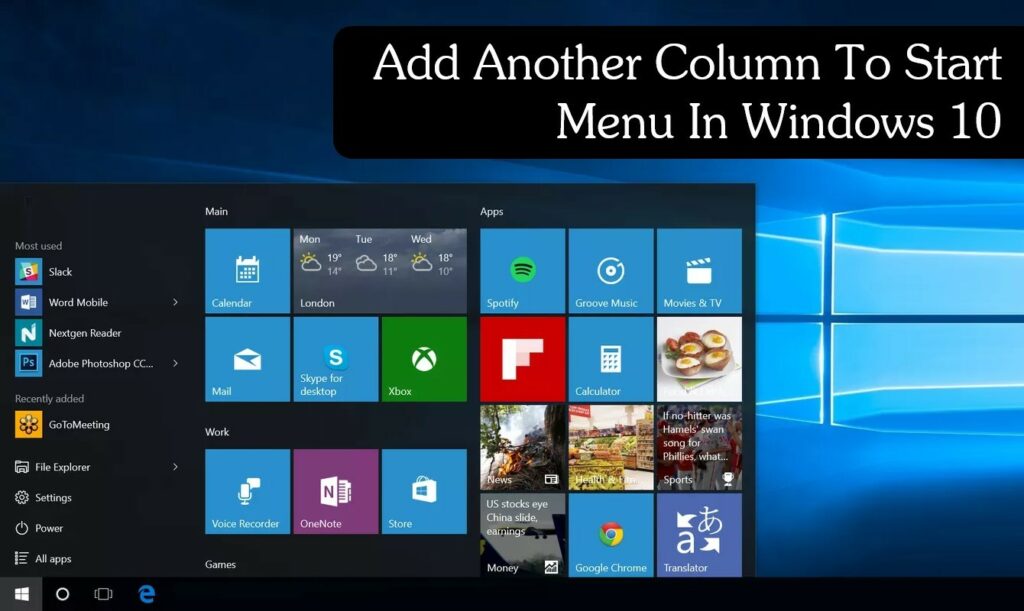Expanding Horizons: A Comprehensive Guide on Adding Another Column to the Start Menu in Windows 10

Introduction
Windows 10, Microsoft’s feature-rich operating system, offers users a customizable and dynamic Start Menu to access applications, settings, and documents efficiently. While the default Start Menu layout is designed for simplicity, users often seek ways to tailor it to their specific needs. One common customization request is the ability to add another column to the Start Menu, providing additional space for organizing and accessing apps. This comprehensive guide will walk you through the step-by-step process of expanding your Start Menu by adding another column in Windows 10.
Section 1: Understanding the Windows 10 Start Menu
1.1 The Central Hub for Navigation
The Start Menu is a central element of the Windows 10 user interface, serving as a launchpad for various applications and system functions.
1.2 Default Start Menu Layout
By default, the Start Menu consists of a single column with a list of frequently used and recently added apps, along with live tiles for a dynamic display.
Section 2: The Need for an Additional Column
2.1 Organizing Apps
As users accumulate more applications, a single-column layout may become cramped. Adding another column offers a cleaner organization and quicker access to a larger number of apps.
2.2 Utilizing Wider Screens
On devices with wider screens, such as desktop monitors or laptops with high resolutions, adding another column makes efficient use of the available space.
Section 3: Adding Another Column to the Start Menu
3.1 Method 1: Using the Default Start Menu Settings
- Right-click on an empty space on the taskbar.
- Select “Taskbar settings.”
- In the settings window, click on “Start” in the left sidebar.
- Toggle the switch for “Show more tiles on Start” to the “On” position.
3.2 Method 2: Modifying the Registry
Warning: Editing the registry can lead to system instability if not done correctly. Proceed with caution.
- Press
Win + Rto open the Run dialog. - Type
regeditand press Enter to open the Registry Editor. - Navigate to
HKEY_CURRENT_USER\Software\Microsoft\Windows\CurrentVersion\Explorer\Advanced. - Right-click in the right pane, choose “New,” and select “DWORD (32-bit) Value.”
- Name the new DWORD as
Start_LargeMFUand set its value to1. - Restart your computer to apply the changes.
Section 4: Verifying the Additional Column
4.1 Checking the Start Menu
After applying the changes, open the Start Menu to see the effects. You should now have an additional column for displaying more tiles.
4.2 Adjusting Tile Sizes
Right-click on a tile, select “Resize,” and choose between small, medium, or wide options to customize the appearance of tiles in the additional column.
Section 5: Reverting Changes
5.1 Using the Default Settings
If you used the default Start Menu settings, follow the same steps to toggle off the “Show more tiles on Start” option.
5.2 Registry Changes
If you modified the registry, return to the Registry Editor, navigate to the same location, and delete the Start_LargeMFU DWORD value.
Section 6: Tips for Organizing the Start Menu
6.1 Grouping Tiles
Organize tiles into groups by dragging and dropping them. Right-click to create a new group and assign a name.
6.2 Pinning and Unpinning Apps
Right-click on an app in the Start Menu to pin or unpin it. This allows you to customize the apps displayed in the Start Menu.
6.3 Alphabetical Sorting
Click on “All apps” to view an alphabetical list of installed apps. Right-click on an app to pin it to the Start Menu for quick access.
Section 7: Troubleshooting and FAQs
7.1 Changes Not Applied
If the additional column doesn’t appear after applying the changes, ensure that you followed the steps correctly and restart your computer.
7.2 Performance Impact
Adding another column to the Start Menu should not significantly impact system performance. If you experience any issues, consider reverting the changes.
Section 8: Exploring Third-Party Start Menu Customization Tools
8.1 Start Menu Alternatives
Explore third-party Start Menu customization tools like Open-Shell (formerly Classic Shell) for more advanced options and features.
8.2 Caution with Third-Party Software
While third-party tools can offer extensive customization, exercise caution and ensure that they are reputable and compatible with your Windows version.
Conclusion
Customizing the Start Menu in Windows 10 is a powerful way to enhance your computing experience, and adding another column provides a practical solution for users with a large number of applications. Whether you opt for the built-in settings or venture into the registry, this guide has equipped you with the knowledge to expand your Start Menu according to your preferences. As you navigate your personalized Start Menu, you’re not just customizing an interface; you’re optimizing your workflow and creating an environment tailored to your needs. Embrace the flexibility that Windows 10 offers, and let your expanded Start Menu be a testament to the adaptability and user-centric design of the operating system. Happy organizing!




